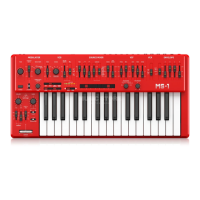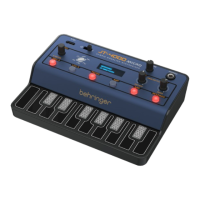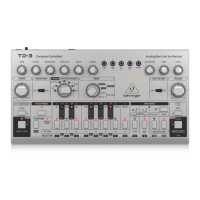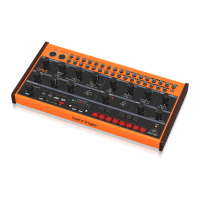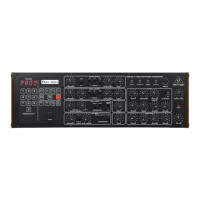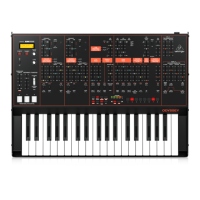26 MS-1 Quick Start Guide 27
(EN)
Step 3: Getting
started
OVERVIEW
This “getting started” guide will help you set up
the MS-1 analog synthesizer and briey introduce
its capabilities.
CONNECTION
To connect the MS-1 to your system, please consult
the connection guide earlier in this document.
Caution: Do not overload the 3.5 mm inputs.
They can only accept the correct level of
voltages as shown in the specication tables. The 3.5
mm outputs should only be connected to inputs
capable of receiving the output voltages. Failure to
follow these instructions may damage the MS-1 or
external units.
SOFTWARE SETUP
The MS-1 is a USB Class Compliant MIDI device, and
so no driver installation is required. The MS-1 does
not require any additional drivers to work with
Windows and MacOS.
HARDWARE SETUP
Make all the connections in your system.
Apply power to the MS-1 using the supplied power
adapter only. Ensure your sound system is turned
down. Turn on the MS-1 power switch.
WARM UP TIME
We recommend leaving 15 minutes or more time
for the MS-1 to warm up before recording or live
performance. (Longer if it has been brought in from
the cold.) This will allow the precision analog circuits
time to reach their normal operating temperature
and tuned performance.
INITIAL SETUP
The following steps will help you get started making
sound with the MS-1.
1. With the power o, connect a pair of
headphones, and turn down the volume knob.
2. In the Source Mixer section, turn up the
sawtooth fader and turn down all the others.
(If all these faders are down, then there will
be no sources to listen to.)
3. In the VCF section, turn up the FREQ fader.
(If the fader is down, then the cuto
frequency of the low pass lter may be
too low.)
4. In the VCA section, set the switch to Gate.
(If it is set to Envelope, then make sure to turn
up the D (decay) fader or the S (sustain) fader.)
5. Turn on the MS-1 and play notes on the
keyboard as you adjust the volume level to a
comfortable listening level.
6. If you hear no sound, hold SHIFT + <KYBD to
make sure you are in Keyboard mode and not
Step mode. Check the REC switch LED is O.
SOURCE MIXER SECTION
The MS-1 has three waveforms, a sub oscillator, an
internal noise generator, and an external source
input. Each of these, and any combination, are used
by the MS-1 to generate sound.
The Source Mixer faders allow you to adjust the
volume of each to create an overall mix.
VCO SECTION
Adjust the Range knob and you will hear the sound
of the various octaves.
The MOD fader allows the VCO to be modulated by
the LFO. Turn up the MOD fader, and then adjust the
modulator controls such as the Rate fader, and the
Waveform selector.
The pulse width fader will adjust the pulse width if
the switch is set to MANUAL. Turn up the Pulse fader
in the Source Mixer section to hear the oscillator. If
the switch is set to LFO (or envelope) then the pulse
width is modulated by the LFO and its controls, (or
the envelope controls) and the pulse width fader
varies the amount of eect.
VCF SECTION
Play with the Frequency fader, and Resonance, and
listen to their eect on the sound.
The ENV fader will adjust the amount of eect the
ADSR envelope controls have on the VCF.
The MOD fader adjusts the amount of modulation
on the VCF. Vary the fader, and adjust the Modulator
LFO rate fader and the waveform.
The KYBD fader adjusts how much the VCF is aected
by the pitch of notes played.
Select an FM Source and then turn up the FM
Amount knob to suit. Listen to the various FM
sources and their eect.
VCA SECTION
The VCA switch allows you to select if the VCA is
aected by the envelope controls, or the keyboard
gate signal.
ENVELOPE SECTION
These faders adjust the VCA if the VCA switch is set
to ENV. In this case, their eect is on the volume
level, and its variation with time.
These faders also adjust the VCF if the VCF's ENV
fader is above minimum. In this case, their eect is
on the cuto frequency and its variation with time.
The VCO pulse width can also be aected by the
envelope controls, if the switch in the VCO section is
set to ENV.
CONTROLLERS SECTION
The GLIDE knob and on/o switch allow you to adjust
the glide time between dierent played notes.
In order for the Bender and handle Bender to work,
the nearby VCO and/or VCF bender faders have to
be above minimum. The main Bender will change
the VCO pitch and VCF in both directions, while
the handle Bender wheel will only increase. Both
Benders can be used at the same time.
Press the MOD switch on the end of the handle,
or move the main unit BENDER up, to add LFO
modulation. The modulation eect depends
upon the setting of the LFO MOD fader and other
LFO controls.
ARPEGGIATOR
To use the arpeggiator, press the ARP switch in the
sequencer section:
1. Press it once to play the arpeggiator. (It stops
when notes are released.)
2. Press it twice, or press HOLD and ARP, to hold
the arpeggio. (It continues when notes
are released.)
The arpeggiator rate is set by the TEMPO/GATE
LENGTH knob.
The order in which the arpeggiator notes are played
has 8 options, and this can be changed by pressing
either <KYBD or STEP> when the arpeggiator is
playing. The LOCATION LED shows the current order
1 to 8:
1. UP 1 5. UP 2 (+ 1 Oct)
2. DOWN 1 6. DOWN 2 (+ 1 Oct)
3. DOWN and UP 7. UP 3 (- 1 Oct)
4. RANDOM 8. DOWN 3 (- 1 Oct)
ACCENT
If you are playing the keyboard, the accent is
automatically triggered when the velocity exceeds
the threshold. (This accent velocity threshold can be
adjusted, or this feature disabled, using the Synth
Tool APP).
To use accent while playing, press the ACCENT
switch:
1. Press and hold to play the note with accent
status. (It stops when the switch is released.)
2. Press it twice to play and hold the accent
status. (The LED ashes slowly.)
NOTE PRIORITY
If more than one note is played at the same time,
the note which is played (the note priority) depends
on the setting of the slide switch in the ENVELOPE
section:
GATE+TRIG: the Last note is played
GATE or LFO: the Lowest note is played.
SEQUENCER
The sequencer allows you to program up to 32 steps
of notes and rests, and to save them as a pattern. Up
to 64 patterns can be recorded, saved, and recalled
in 8 banks of 8 patterns.
The sequencer has two modes of operation:
KEYBOARD mode, where you can create and store
a pattern, and STEP mode, where you can interact
while composing a pattern.
Details of the Sequencer operation are shown on
page 16 and 36.
FIRMWARE UPDATE
The SynthTool App is available as a free download
from the MS-1 product page of our website:
behringer.com.
The latest le can be downloaded and stored on
your computer, and then used to update the MS-1
if required.
HAVE FUN
The MS-1 has various Gate and CV inputs and
outputs that allow for further experimentation
and expansion to other MS-1 units and modular
synthesizer equipment.
With all these controls, the possibilities for musical
creativity are endless. We hope that you will enjoy
your new MS-1.
MS-1 Getting started
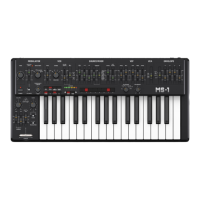
